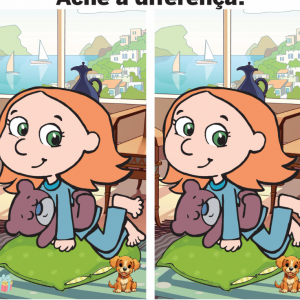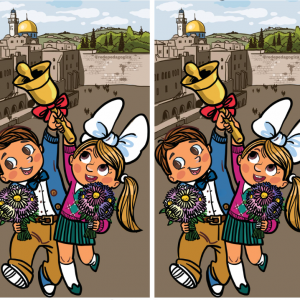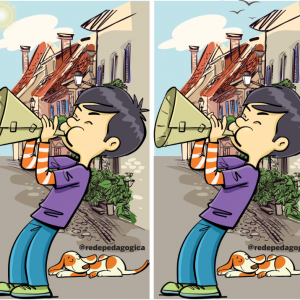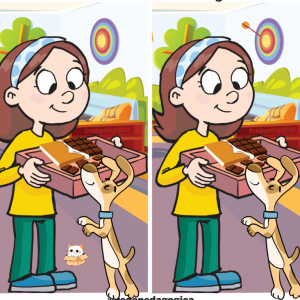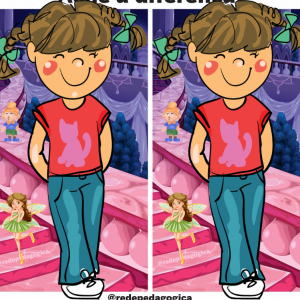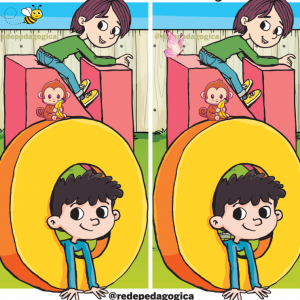The Benefits of Visual Puzzles: Why ‘Spot the Difference’ Games Are More Than Just Fun
“Spot the difference” puzzles have become a staple of children’s activity books, but they’re not just entertaining — they offer numerous cognitive and developmental benefits that extend well beyond simple fun. These types of puzzles, like the one featuring a young girl with a red book and the task of finding subtle discrepancies between two similar images, are an excellent tool for improving focus, problem-solving skills, and even emotional intelligence.
In this article, we’ll explore how engaging in visual puzzles can improve various cognitive and social skills and why they’re so much more than just an enjoyable pastime.
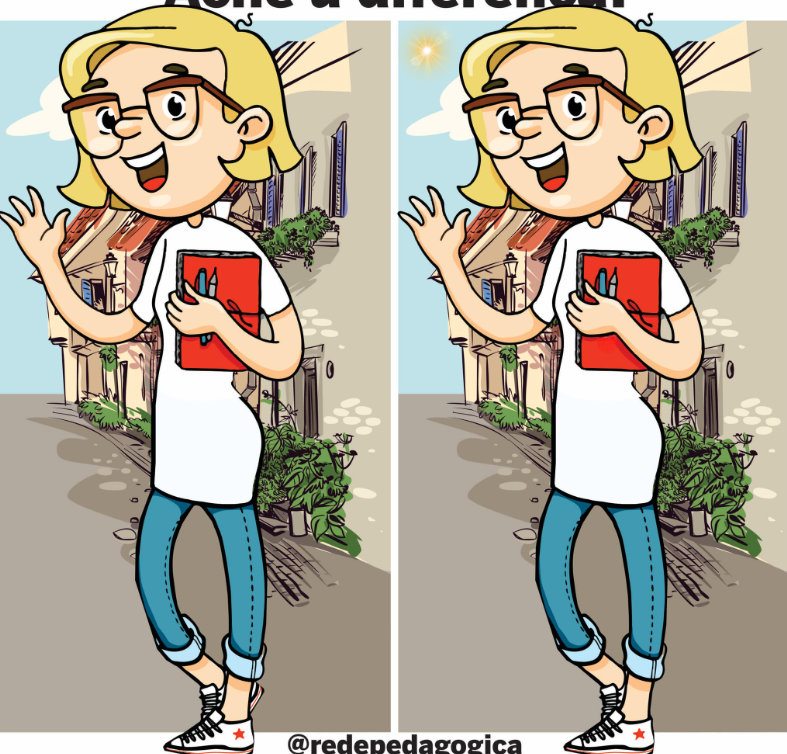
How ‘Spot the Difference’ Games Improve Cognitive Skills
Enhancing Attention to Detail
One of the main benefits of “spot the difference” puzzles is that they sharpen attention to detail. Players need to look at two almost identical pictures and spot small differences. This requires a high level of concentration and attention to minor details. Whether it’s a change in color, position, or the addition of a small object, players need to be precise in their observation.
In the image of the young girl holding a book, for example, small differences — like a change in the background or an item on her backpack — require the player to examine each part of the image closely. This strengthens the brain’s ability to focus on and process small visual cues.
Boosting Memory and Visual Processing
These puzzles not only improve attention to detail but also help boost memory. Players must recall the initial image and compare it with the second, challenging them to retain and process visual information. The more frequently these puzzles are completed, the better individuals become at recalling visual data, which is a crucial skill in both academic and professional settings.
Visual processing abilities also improve through repeated practice. The brain becomes more adept at analyzing and interpreting visual inputs, which is vital for tasks ranging from driving to navigating complex data in the workplace.

Developing Problem-Solving and Critical Thinking Skills
Fostering Problem-Solving Abilities
At its core, “spot the difference” games are exercises in problem-solving. To succeed, players must analyze the two images and figure out where the differences lie. This requires patience and persistence, especially when the differences are subtle.
By engaging in such puzzles, children (and adults) develop critical thinking skills that they can transfer to real-world situations. Whether it’s troubleshooting a technical issue or analyzing a situation at work, the ability to think critically and systematically is a valuable skill that benefits all areas of life.
Learning to Overcome Frustration
Another often-overlooked benefit of these puzzles is learning how to handle frustration. Sometimes, the differences can be difficult to find, leading to moments of frustration. These games teach players to be patient, calm, and persistent in the face of challenges — an essential life skill. Like the young girl in the image, the ability to remain focused and not give up after missing a difference can help build resilience.
Building Emotional Intelligence Through Visual Puzzles
Managing Emotions and Stress
Playing games like “spot the difference” helps children manage their emotions. These puzzles can serve as a safe space where kids can experience feelings like frustration or excitement while learning how to regulate those emotions.
By working through challenges in a low-pressure environment, children develop a sense of accomplishment, boosting self-esteem. Similarly, they also learn to deal with minor setbacks, such as initially failing to find the differences, and develop the emotional strength to keep going. Over time, this builds emotional resilience that is valuable in school and personal life.
Developing Patience and Perseverance
When searching for differences in the images, players often have to wait for clues or persist through difficult patches. This teaches the value of patience — an important trait for emotional development. By learning to tolerate minor frustrations, children grow more patient in other aspects of their lives.
For example, when playing “spot the difference,” the challenge of searching for differences without immediately finding them mirrors situations in life that require ongoing effort and perseverance. Whether it’s studying for exams or trying to achieve personal goals, developing patience during puzzles translates into real-life benefits.

Social Benefits: Playing Together and Learning Cooperation
Building Social Bonds Through Shared Experiences
While many people engage in these puzzles individually, “spot the difference” games can also be enjoyed in groups. In a family setting or with friends, playing together fosters cooperation and teamwork. Players might share ideas or point out differences together, leading to fun conversations and collaboration.
The cooperative aspect of these puzzles promotes social bonds and helps improve communication skills. It also provides opportunities for children to practice listening, turn-taking, and sharing their observations in a respectful manner, which are vital social skills.
Encouraging Healthy Competition
When played in a group, “spot the difference” games can foster healthy competition. Players may race against each other to find the differences first, motivating them to be quick and accurate. While the competition may be lighthearted, it teaches children how to handle wins and losses gracefully — another important social skill.

Improving Focus and Mental Agility
Training the Brain for Better Focus
The concentration required for these puzzles has long-term benefits for mental agility. Studies have shown that puzzles help strengthen the brain’s focus and attention mechanisms, which can improve memory retention and overall cognitive performance.
In an age where distractions are abundant, activities that encourage concentration, like “spot the difference” games, help train the brain to stay focused for longer periods of time. This is especially beneficial for academic success, where focus is crucial for absorbing information.
Enhancing Visual Memory and Recognition
“Spot the difference” games also train the brain to remember images and patterns, which improves visual memory. As players continue to solve these puzzles, they become more adept at recognizing patterns and noticing changes in their surroundings. This ability to recognize subtle details is useful in everyday life, from identifying missing items to solving complex tasks.
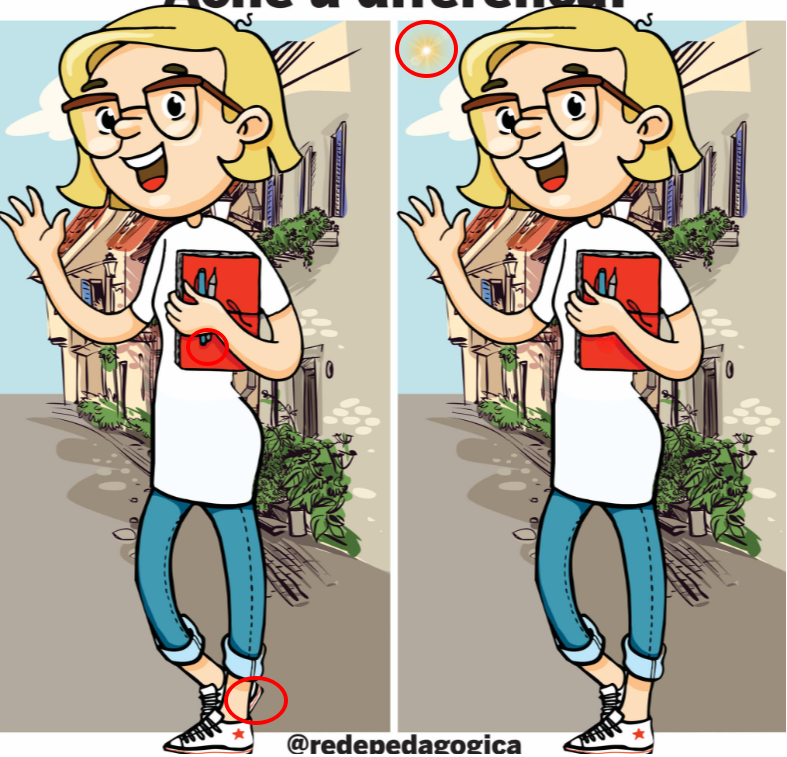
Conclusion: A Fun and Valuable Cognitive Tool
“Spot the difference” games are much more than just a fun activity — they are powerful tools for cognitive development, emotional intelligence, and social learning. Through these puzzles, children (and adults) develop crucial skills like attention to detail, problem-solving, patience, and perseverance. They also improve emotional resilience and cooperation, essential life skills that extend far beyond the world of visual puzzles. So next time you engage in a “spot the difference” game, take a moment to appreciate how much your brain is learning and growing with each turn of the puzzle.
